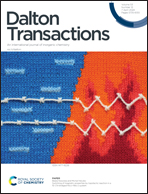In situ grown Bi2WO6@CoMoO4 layered cladding structure on carbon nanofibers by a two-step solvothermal method and Ti mesh substrate as advanced counter electrodes for dye-sensitized solar cells†
Abstract
Based on carbon nanofibers (CNFs) with excellent electrical conductivity, a three-layer cladding structure CNFs@Bi2WO6@CoMoO4 material was prepared by a two-step solvothermal method, which effectively combines the great catalytic ability of transition metal oxides with the good conductivity of CNFs. Titanium (Ti) mesh was used as the conductive substrate and CNFs@Bi2WO6@CoMoO4 was scraped on it to prepare paired counter electrodes (CEs), and then dye-sensitized solar cells (DSSCs) were assembled by unifying with photoanode and iodine electrolyte. The photoelectric conversion efficiency (PCE) of 9.41% (with Voc of 0.784 V, Jsc of 17.90 mA cm−2 and FF of 0.72) was obtained under standard light conditions (AM 1.5 G). In brief, this study found a cheaper and better alternative material for Pt and also provides more possibilities for the selection of conductive substrate for CEs.



 Please wait while we load your content...
Please wait while we load your content...